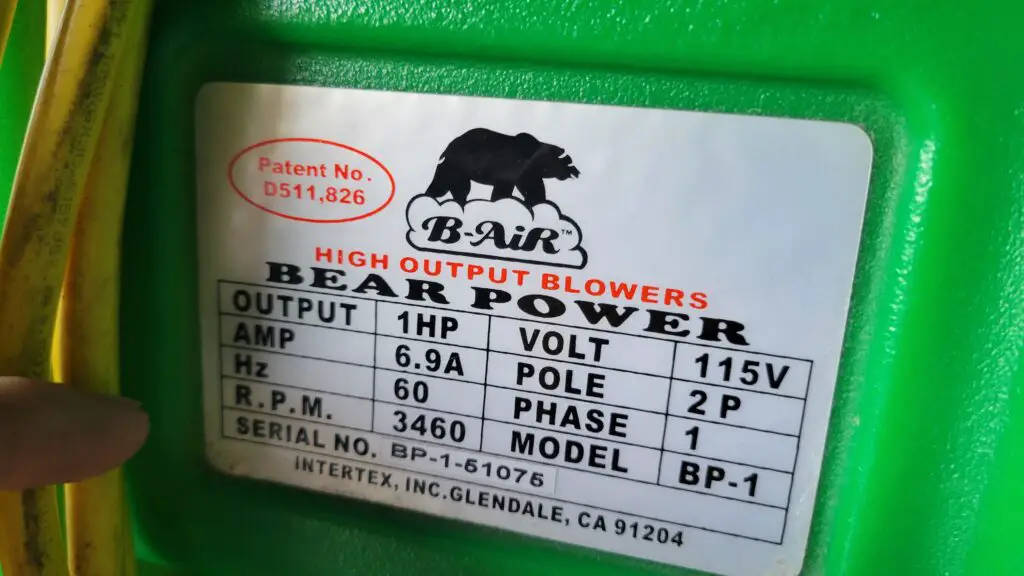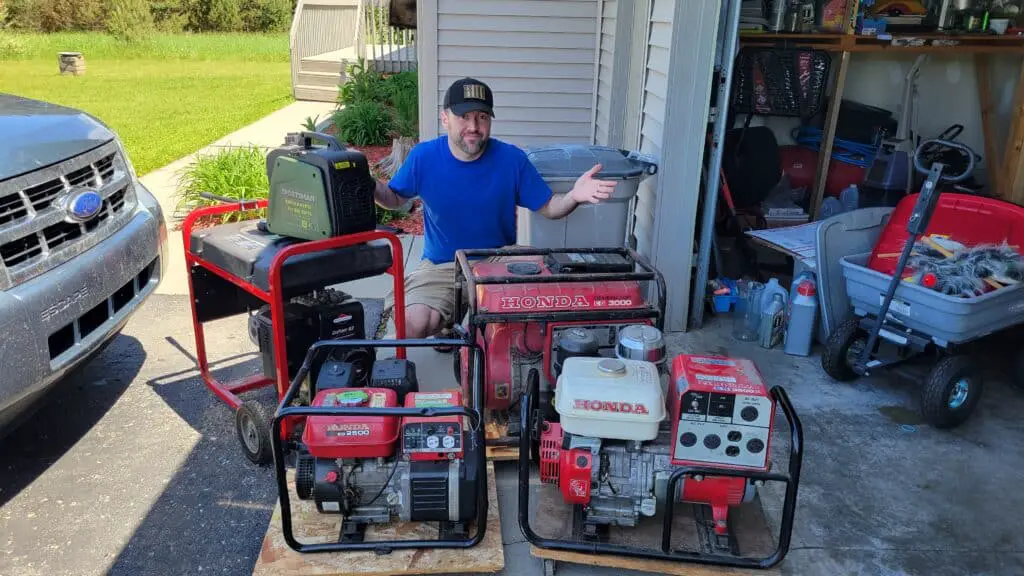Bounce houses, bouncy castles, jump houses, and inflatable obstacle courses are all amazing at bringing a party to life — especially if lots of kids are around. Often times we can plug these into our home outlets and be just fine, but what if we have a large backyard and want to place it away from the house? What if we have a special event that we need to set up that is at a local park?
For the last several years I have been lending all of my generators to my church in order to power the blower motors for the bounce houses and other large inflatables.
I thought I’d take a quick moment to share how much power a bounce house uses, the generator size required to power it, and some important extension cord information to keep you from burning up your blower motors.
There are certainly subtleties to this topic, and I’ll address them in the rest of this short article, but if you are just here for a “one size fits all” answer, then here it is.
As a general rule, an inflatable bounce house with a single blower motor can be powered by a 2,000 watt generator and a dedicated 15 or 20-amp breaker (depending on the size of the blower motor). An extension cord may be used as long as it is 50′ or less and 10 or 12 gauge in size.

How Much Power Does a Bounce House (Inflatables) Use?
Generally, bounce houses and inflatable blower motors will come in one of the following three sizes:
- 1HP
- 1.5HP
- 2HP
The abbreviation “HP” stands for horsepower.
Some inflatables may have two or more blower motors, depending on their sizes.
When you first start the bounce house blower motors, they require much more power than when they have fully inflated the bounce house and are just maintaining the air pressure inside as a portion of the incoming air is lost through the seams.
Typically, a 1HP bounce house blower motor will require 1,200 watts (10.5 amps) when inflating the structure, but will drop to 750 watts (6.5 amps) to maintain the structure when it is fully inflated.
As we move up in size, a 1.5HP bounce house blower motor will require 1,350 watts (12 amps) when inflating the inflatable, and 900 watts (7.5 amps) to maintain the inflatable when fully inflated.
Finally, a 2HP bounce house blower motor will require 1,650 watts (14 amps) to inflate an inflatable, and the running watts when maintaining a fully inflated structure will be about 1,150 (8.5 amps).
| Bounce House Blower Motor Size | Running Watts When Inflated | Running Watts When Inflating |
|---|---|---|
| 1HP | 750 | 1,200 |
| 1.5HP | 900 | 1,350 |
| 2HP | 1,150 | 1,650 |
What Size Generator is Needed to Power a Bounce House (Inflatable)?
As we can see above, a 2HP blower motor (and below) requires less than 2,000 watts when either inflating or maintaining the bounce house.
As a general rule, a 2kW-2.5kW (2,000-2,500 watts) generator is the bare minimum output to power a single 1-2HP bounce house blower motor. The generator should have a dedicated 20amp breaker for the task and a 10-12 gauge extension cord may be used as long as it is 50′ or less.
That’s the generic and overarching answer to the question. There are a few subtleties that should be addressed though.
| Bounce House Blower Motor Horsepower (HP) | Absolute Minimum Generator Size | Recommended Minimum Generator Size | Required Breaker Size |
|---|---|---|---|
| 1 HP | 2,000 Watts (2kW) | 2,000 Watts (2kW) | 15 Amp |
| 1.5 HP | 2,000 Watts (2kW) | 2,500 Watts (2.5kW) | 15 Amp |
| 2 HP | 2,500 Watts (2kW) | 3,000 Watts (3kW) | 20 Amp |
A “dedicated breaker”, as mentioned above, simply means that you are only powering the bounce house blower motor with that set of outlets. You’re not plugging the bounce house into the bottom receptacle and a power tool into the top one. You’re also not putting a “T-connection” in the extension cord with a splitter.
Most generators will have one or more sets of 120v outlets and they will either be 15 or 20 amp.
You can definitely power a 1HP inflatable blower motor with a 15 amp breaker, and you can most likely power a 1.5HP blower motor as well. I’ve accomplished both tasks just fine with such a setup.
However, a 2HP inflatable blower motor flirts with (and sometimes exceeds) the 15-amp threshold and if this happens you’ll keep tripping your breaker and you won’t be able to power the motor. It is always best to power a 2HP inflatable blower motor with a 20-amp breaker.

Keep in mind that every inflatable blower motor is different, and some are more energy efficient than others. Some have windings inside that are in better shape than others. Some have been damaged from improper voltage and consume more power.
If you’re renting a bounce house, you never know what shape the motor is in.
I have successfully powered bounce house blower motors with a 2kW generator, a 2.5kW generator, a 3kW generator, a 3.5kW generator, and I’ve powered two bounce house motors simultaneously with a 5kW generator.
My personal recommendation is that if you need to power a single bounce house blower motor from the 1-2HP range, I would go with a 2.5kW generator so that you’re not overloading the generator at any point. I personally don’t like to run my generators near their max capacity, and I like to give myself a 20% buffer to not shorten the lifespan of the generator.
Again, I have successfully powered two blower motors at the same time with my 5kW generator which has a single 20-amp breaker. Though it’s generally not recommended, I’ve successfully done this for several years now without a problem. Your mileage may vary based upon your generator, as well as the size and condition of the motors you plan on powering.
Do I need certain Extension Cords when Powering Inflatables with a Generator?
Let’s face it, generators are noise making monsters! Of course, a Honda is going to be much quieter than most other brands, but they’re still annoying to have around and drown out the happy laughter of all the kids (and adults) playing inside and around the bounce houses.
Before switching to an extension cord to create distance, make sure the exhaust of the generator is pointed away from the bounce house and also not at a structure that bounces the sound right back to the party.
Does that help?
If that doesn’t cut it, then you can use an extension cord.

Do not exceed 50′ and do not use a gauge (wire size) higher than 12.
Here’s a table to outline the basics of powering a bounce house with a generator while using extension cords.
| Extension Cord Gauge | Can it be Used to Power a Bounce House? | Maximum Length | Notes |
|---|---|---|---|
| 16 Gauge | No | N/A | Will burn up the motor |
| 14 Gauge | No | N/A | Will burn up the motor |
| 12 Gauge | Yes | 50′ | Exceeding 50′ can burn up the motor; 25′ recommended if possible but not required |
| 10 Gauge | Yes | 50′ | More expensive and harder to find, but this size can certainly be used |
Personally, I recommend no more than 25′ and 12 gauge.
The longer the cord, the more you’ll experience voltage drop. So, you may have 120 volts at the outlet on the generator, but by the time it travels down a 100′ cord you may only have 106 volts to plug into. Yes, the blower motor may start and appear to run just fine — for a while — but you’ll eventually burn the motor up.
Again, as long as it is 50′ or less, and at least 10 or 12 gauge, you will be just fine.
